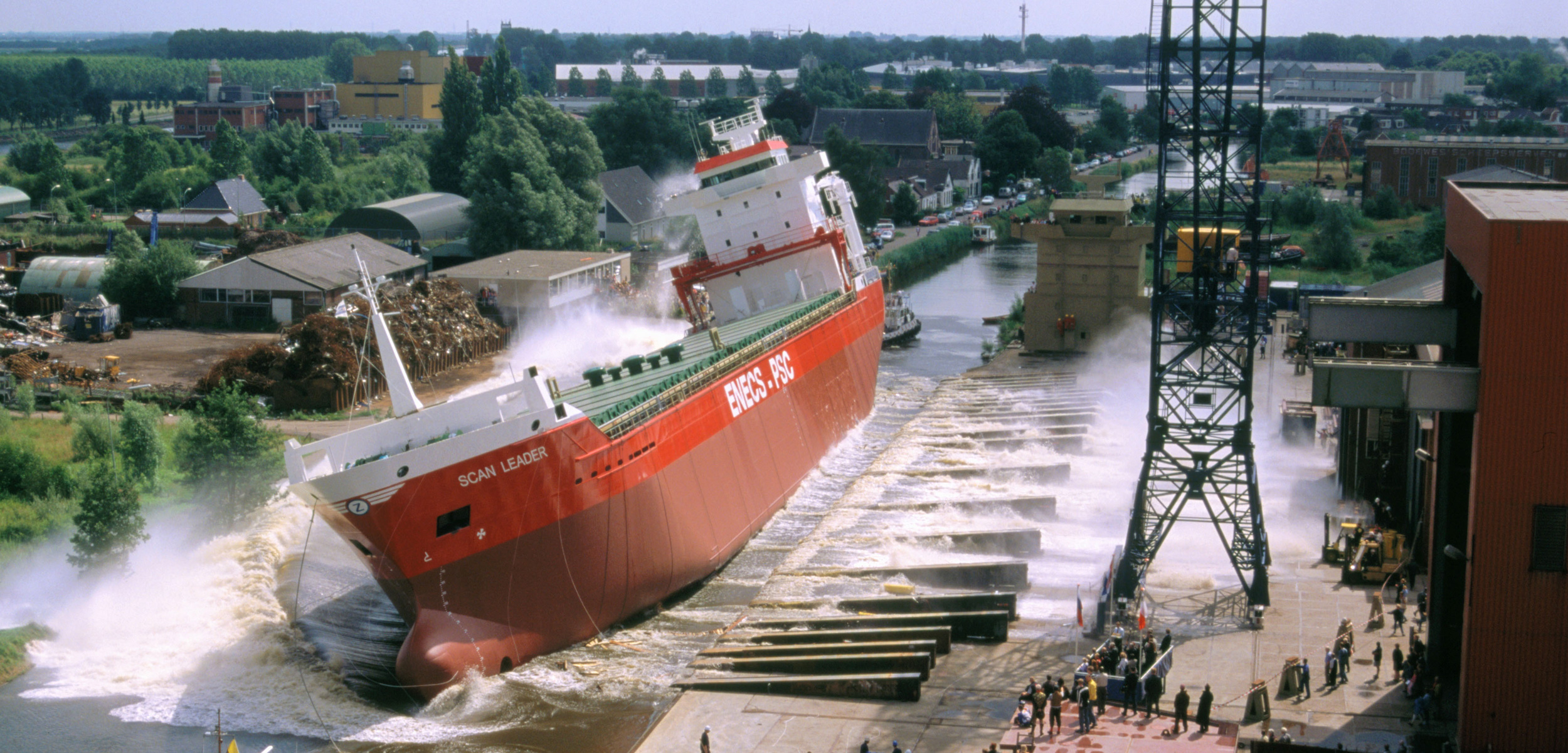Five Ways to Float Your Boat
Big ships are built on land. Here are five ways to get them in the water.
Article body copy
Shipbuilders launched the RMS Titanic on May 31, 1911, before a crowd of 100,000 onlookers. The spectators cheered as the vessel slid down a slipway greased with 20 tonnes of sperm whale oil, soap, and tallow, and successfully floated on the calm waters of the Victoria Channel in Belfast Lough, Northern Ireland. When launching such a massive multi-tonne vessel, shipbuilders consider many things, from the size of the ship to the site logistics, so they can use the best method to get the ship in the water. A successful launch can be a celebration, but the slightest miscalculation can spoil the party, even claiming lives or sinking the ship. Here are five ways to launch a ship, and five ways a launch can end terribly.
Longitudinal Slipway
Launching a vessel down a tilted slipway is an old method: ancient Egyptians used slipways to guide vessels into the Nile during portages. Modern shipbuilders use a structure called a longitudinal slipway (also called a slideway). Once the ship is ready, shipbuilders position it at the top of the lubricated slipway, remove scaffolding and supports, and activate an electrical, mechanical, or hydraulic trigger that sends the vessel down the slide, stern first. Longitudinal slipways work well for large ships, including early 20th-century luxury liners such as the Titanic.
Put a badly built vessel on a slipway and, well, things can go sideways. Literally. When the Principessa Jolanda was launched at the Riva Trigoso shipyard near Genoa, Italy, in 1907, things started out well. The 149-meter luxury liner entered the Mediterranean as planned, but to the horror of the onlookers, started listing to port. Inside, unsecured items and furniture shifted, tilting the ship even farther. Water spilled into open portholes and by the end of the day, Jolanda was fully submerged. Shipbuilders later concluded that the ship’s center of gravity was too high.
The Principessa Jolanda tips over shortly after launch.
Side Launch
The longitudinal slipway’s splashier cousin launches a ship sideways down a sloped dock into the water, like a person falling out of bed. The sloped surface is much shorter than the longitudinal slipway, so this technique is particularly useful in cramped quarters, such as an inland waterway, and works best if vessels are no longer than 100 meters. Ships make quite a splash when they tilt into the water, sometimes swamping spectators, which can be hilarious and even dangerous. When the National Oceanic and Atmospheric Administration’s Reuben Lasker was launched into Wisconsin’s Menominee River in 2012, the ship sent up a wall of water and debris that swamped a nearby dock and some unlucky onlookers near the stern.
The Reuben Lasker makes a splash.
Airbag Launch
A cross between rolling logs and a bouncy house, airbags were first used to launch ships in the early 1980s in China. The method involves inflating cylinder-shaped airbags underneath a vessel that is resting on a dock, slipway, or even a beach. Then, shipbuilders carefully push the ship over the rolling bags, which can be as big as a tank on a tanker truck, and into the water. The tough and reusable bags are made from layers of rubber and synthetic cords, so they can handle nearly any size of vessel, from small fishing trawlers to 63,500-tonne bulk carriers.
In September 2011, Chinese shipbuilders used airbags to launch the 32-meter, US $2.5-million vessel SS Jiugang into the Yellow River. Unfortunately, the builders miscalculated the entry angle and the river’s depth, and the ship—roughly the length of an NBA basketball court—sank stern first into the murky water.
The SS Jiugang wallows in the water after a faulty launch.
Dry Dock
The dry dock concept dates back to at least the 10th century, when Chinese shipbuilders cut a basin into a shoreline, sealed the opening with a gate, and used waterwheels to drain the basin dry. The concept has stayed the same over the past millennium. Today, shipbuilders create a basin, seal out the sea with a gate, and pump the basin dry. They build the ship in the basin, and when it’s done, the dry dock is carefully flooded. Then the gates are opened and the new ship heads out to sea. Dry docks are best for massive or complicated vessels such as cargo ships, submarines, or aircraft carriers.
Though dry-docking is relatively straightforward, accidents do happen, especially when the gates or flooding machinery fails. In 2002, at least 22 workers died in Dubai when a dry dock gate broke and a 12-meter-high surge of water rushed inside, flooding the dock and submerging several ships within a few minutes.
A dry dock is flooded around the aircraft carrier USS Gerald R. Ford.
Cranes
Cranes with slings or hoists come in handy on docks, when there are no slipways, or at sea, when large ships need to offload smaller vessels such as tenders, research boats, or inflatables. Crane operators need precise timing, a keen understanding of a vessel’s balance and weight, and a light hand. Lifting and rigging slings can break, boats can slip, and crane operators can miscalculate. In New Zealand in 2014, a crane operator was lifting a boat when a gust of wind knocked the crane off balance and onto a nearby house. Thankfully, no one was seriously hurt.
This compilation of crane launches shows the many ways the method can go awry.

